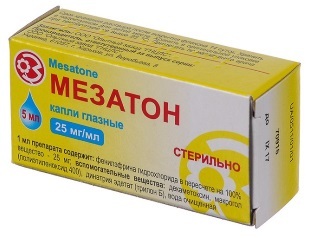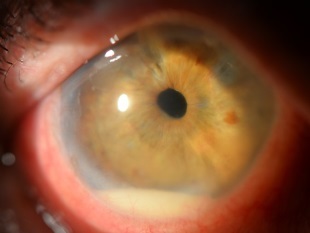
In arterial hypotension of different genesis, a less sharp and prolonged increase in pressure is often required than with the use of catecholamines( epinephrine, norepinephrine).
Mesaton is used in such cases. Phenylephrine hydrochloride - the active substance of the drug, in its action is alpha-adrenomimetikom.
But unlike catecholamines, it practically does not undergo the action of catechol-O-methyltransferase, which explains the duration of the action.
Mesaton can be used in the form of injections, as well as eye or nasal drops. We bring to your attention the description of instructions for the use of the drug in our article.
- 1. Instructions for use
- 2. Side effects of
- 3. How to store
- 4. Cost of
- 5. Analogues of
- 6. Reviews of
- 7. Conclusions
Instructions for use
Pharmacodynamics

The drug belongs to selective alpha-1-adrenomimetics of synthetic origin. By stimulating the receptors of blood vessels, it causes their constriction. This increases the pressure in arteries and arterioles and reflexively increases heart rate.
Unlike catecholamines, Mesaton does not affect beta adrenoreceptors located in the heart, and the magnitude of cardiac output.
In local use( eye drops), the drug exhibits a mydriatic effect( dilates the pupil), while decreasing the pressure of the intraocular fluid. The drug does not affect accommodation.
The action of Mesoton begins immediately after application and continues:
- 20 min.- when injected into a vein;
- 50 min.- under the skin;
- 1.5 hours - intramuscularly.
When using eye drops the maximum expanding effect is achieved after 15-20 minutes and lasts 4-6 hours.
When
- is applied Hypotension, collapse, or shock.
- Hypotonic disease.
- Vascular insufficiency( eg, overdose of vasodilating drugs).
- Allergic or vasomotor rhinitis. Intoxication and infection.
- With surgical interventions or preparation for them.
- For the dilatation of the pupil( with inflammation of the iris - iritis).
The ability of Mesaton to constrict vessels can be used in local anesthesia( the anesthetic suction is reduced).In this case, the drug replaces adrenaline.
How to use
- Intravenously spray( with collapsing conditions): 1% solution in an amount of 0.1ml should be diluted in 20ml 0.9% solution of sodium chloride or 5% glucose solution. If necessary, repeat the procedure using a larger amount of the drug( 0.3-0.5 ml).
- Droppers: in 250-500 ml isotonic solution dilute 1 ml of 1% Mesaton solution.
- Intramuscularly or subcutaneously: 1% solution is administered 2-3 times a day in an amount of 0.3-1 ml.
- Locally( to affect the nasal mucosa and to remove signs of inflammation): 0.25-0.5% solution lubricate the internal surface of the nostrils or inject the drug by instillation.
- In the conjunctival sac( to widen the pupil), add a solution of 2-3 drops.
Features of the
During the period of Mesaton therapy, it is necessary to keep such parameters as blood pressure, ECG, IOC, as well as blood circulation in the place where the injection was made, and in the extremities.
If a medical collapse occurred in a patient with hypertension, the target level of pressure in the systole should be lower than the usual 30-40 mm Hg.
Elimination of hypovolemia, acidosis and restoration of the balance between the partial pressures of carbon dioxide and oxygen in the blood is necessary in the treatment of shock conditions.
If serious cardiac arrhythmias or abrupt changes in blood pressure values occur, Mezton's therapy is immediately stopped.
Discontinuation of patient therapy Mezaton should be administered with a gradual dose reduction to avoid re-increasing the pressure. This is especially important after a long treatment. If the pressure dropped to 70-80 mm Hg.then the administration of the drug should be resumed.
It is important to consider that the use of Mesaton in conjunction with drugs that stimulate labor activity( for example, ergot alkaloids, vasopressin), can lead to persistently high blood pressure in the postpartum period.
When treating Mesatone, do not drive a car or do anything else that requires attention.
Form and Composition
Mezaton is currently registered as a 1% injection solution( 10 mg / ml) in 1 ml ampoules. The package contains 10 ampoules and an ampoule scarifier.

Is also available in the form of eye drops. 1 ml of solution contains:
- main substance - phenylephrine hydrochloride( 25 mg);
- additional components - decametoxin, polyethylene oxide 400, disodium ethylenediaminetetraacetic acid, purified water.
Packing: 5 ml polyethylene bottle with a dispenser cap.
In addition, phenylephrine in the form of other dosage forms( nasal or ocular drops, sprays) exists under other trade names.
Drug Interactions
Alpha-blockers, antihypertensives, phenothiazines, as well as diuretics, reduce the effect of Mesatone.
ergot alkaloids, monoamine oxidase inhibitors, tricyclic antidepressants, promote hypertensive action, and adrenomimetics are also arrhythmogenic.
The effect of reflex tachycardia can be neutralized by beta-blockers. It should be borne in mind that when taking reserpine at the same time, hypertension occurs due to the depletion of your own supply of adrenaline and norepinephrine and an increase in arterial sensitivity to adrenostimulants.
There is a mutual oppression of the pressor effect of Mesatone and the antianginal action of nitrates. Thyroid hormones contribute to the mutual enhancement of effects, including the risk of coronary insufficiency, especially if the patient has coronary atherosclerosis.
Side effects of
Most often observed hypertension, arrhythmia, cardialgia.
The appearance of insomnia, weakness, headache or other similar manifestations from the side of the central nervous system is not excluded. It is also possible necrosis of the skin in the place where the injection was made( excessive vasoconstriction leading to necrosis), pallor of the skin, oliguria.
Overdose of
Accompanied by arrhythmia( ventricular extrasystole), and excessive pressure increase. In the head and limbs, a sensation of heaviness may appear.
Treatment is carried out with short-acting alpha-blockers( use phenotholamine intravenously).If there is a failure in the rhythm of the heart, it is rational to use beta-adrenergic receptor blockers( for example, Anaprilin).
A useful collection of articles for the preservation of eye health:
- Choose eye drops against redness and irritation
- Eye drops for those who sit behind the monitor
- How to properly instill drops in the eyes?
Contraindications
Can not be used with:
- closed-angle or narrow-angle glaucoma;
- elderly age, in case of violations of the vessels, heart, cerebro-vascular system;
- violation of the integrity of the eyeball;
- failures in the work of tear production;
- hepatic porphyria;
- hyperthyroidism;
- individual intolerance of components;
- is a congenital deficiency of glucose-6-phosphate dehydrogenase.
The drug should be taken with caution in the presence of a history of atherosclerosis, a tendency to thromboembolism, impaired renal function, diabetes mellitus.

Pregnancy and lactation
Due to the lack of safety data for Mesatone when used during pregnancy, the drug should be taken only if the intended beneficial effect for the patient is higher than the risk for the child.
It is contraindicated for women who are breast feeding.
How to store
| Site requirements | Dry location, away from sunlight |
| Temperature | 15-25 оС |
| Shelf life | The drug is stored for 3 years |
Price
In Russia Mesaton solution costs approximately 45 руб., and in the pharmacies of Ukraine - 20 UAH .
Analogs

Structural( contain the same active substance):
- Irifrin. Contains 2.5% phenylephrine solution and is released as eye drops.
- Neosinephrine-Pos, eye drops
Functional( selective alpha-adrenomimetics):
- Ethylphrine. Increases the pressure for a longer period than Mesatone, but is weaker.
- Midodrin. Prodrug. Narrows the vessels more durably and evenly than Mezaton. There is not only a solution for parenteral administration, but also in the form of tablets. It is also used for orthostatic hypotension.
Reviews
Currently, Mesatone's injection solution is often prescribed by ophthalmologists as eye drops. When using it in this way, not all patients are happy with the result of treatment: side effects are observed in the form of irritation of conjunctiva, itching, redness.
This can be explained both by the allergogenicity of the preparation and by its improper storage after opening the ampoule( the solution does not contain preservatives and is quickly seeded with microorganisms capable of initiating inflammation).
For this reason, if Mesaton was appointed as an ophthalmologist, it is better to replace it with one of the analogues, for example, Irifrin.
People who received Mesoton intravenously due to shock, collapse, or surgery did not express dissatisfaction with the drug. On the contrary, they noted good health after the operation and no pressure surges.
If you or your friends or relatives have experience of taking this drug, please leave your feedback on our website. This can help future visitors: both patients and doctors.
Conclusions
So, Mezaton:
- A drug that effectively increases pressure by narrowing the vessels without affecting cardiac output.
- Can cause reflex tachycardia.
- Contraindicated in admission for a number of cardiovascular diseases, children, lactating and pregnant women.
- Can be administered as eye drops
- Has a low cost.
